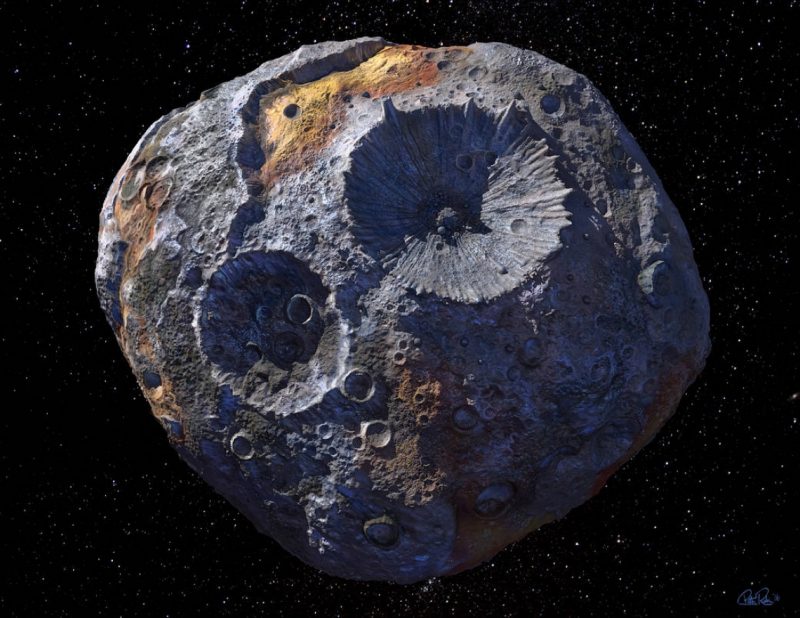
Asteroid Psyche: Metal core or rubble pile?
In 2022, NASA will launch a mission to the asteroid known as 16 Psyche. It’s our first mission to a world that isn’t primarily rocky or icy, but instead metallic. Scientists have said Psyche might be the exposed metal core of an early planet that failed to form. They’ve estimated its worth at $10,000 quadrillion. Now a new study suggests something else. On June 9, 2021, scientists at the University of Arizona announced the results of a new study, suggesting asteroid Psyche might not be as expected. It might not be as metallic or as dense as scientists once thought. Instead, these scientists said:
Rather than being an intact exposed core of an early planet, it might actually be closer to a rubble pile.
The peer-reviewed Planetary Science Journal study published this study on May 12, 2021.
The study – led by David Cantillo of the University of Arizona – found that Psyche is 82.5% metal, 7% low-iron pyroxene (rock-forming minerals) and 10.5% carbonaceous chondrite (stony). Its bulk density, or porosity, is around 35%. These numbers mark Psyche as less metallic and more porous than previous studies. Previous estimates had Psyche at as much as 95% metal and significantly less dense. Cantillo commented in a statement:
That drop in metallic content and bulk density is interesting because it shows that 16 Psyche is more modified than previously thought.
The new estimates point to Psyche being a “rubble pile” instead of a failed planetary core. A rubble-pile composition would make Psyche more similar to other asteroids in our solar system, such as the recently visited asteroid Bennu. Cantillo said:
Psyche as a rubble pile would be very unexpected, but our data continues to show low-density estimates despite its high metallic content … Having a lower metallic content than once thought means that the asteroid could have been exposed to collisions with asteroids containing the more common carbonaceous chondrites, which deposited a surface layer that we are observing.

Psyche is BIG, for an asteroid
When astronomers began finding the first asteroids, in the 1800s, of course they found the biggest and brightest ones first. Psyche was the 16th asteroid to be discovered, on March 17, 1852. Psyche is the size of the state of Massachusetts, or the country of Slovenia. It contains 1% of all the material in the asteroid belt.
The name asteroid means starlike. Asteroids got this name because they looked like little stars through early telescopes. Now scientists can study close-passing asteroids using radar. But a distant asteroid like Psyche – which orbits in the asteroid belt between Mars and Jupiter – is a different story. Astronomers had determined Psyche’s composition and porosity by analyzing sunlight reflected from its surface. Cantillo’s team used a different method. The team recreated the asteroid’s surface materials in a lab. They mixed different ingredients until the light patterns they were measuring matched those of the telescopic observations of Psyche.
And so they acquired the surprising results: Psyche isn’t as metallic or dense as expected. Scientists would expect a higher porosity on an asteroid such as Bennu. That’s because Bennu is only about the size of the Empire State Building and doesn’t have a strong-enough self-gravity to pack itself together tightly.
On the other hand, astronomers expected a big asteroid like Psyche to be less porous and less like, well, rubble.
When will we know? Scientists will learn Psyche’s true metallicity, and its true density, in 2026 when the NASA mission arrives at this asteroid. Cantillo said:
The opportunity to study an exposed core of a planetesimal is extremely rare, which is why they’re sending the spacecraft mission there. But our work shows that 16 Psyche is a lot more interesting than expected.
$10,000 quadrillion asteroid Psyche?
By the way, you can’t (at present) put a true price on objects such as asteroids. But many have tried to estimate the worth of asteroid Psyche, with its metal-rich composition. One estimate suggests the massive, metal-rich object is worth $10,000 quadrillion (that’s 15 more zeroes), more than the entire economy of Earth.
If Psyche isn’t as dense as once believed, this estimate will go down.
Still, to scientists, Psyche will remain … priceless.

Bottom line: New estimates suggest that asteroid Psyche is less metallic and dense than previously thought. Therefore it may not be a failed planetary core but a rubble pile.











